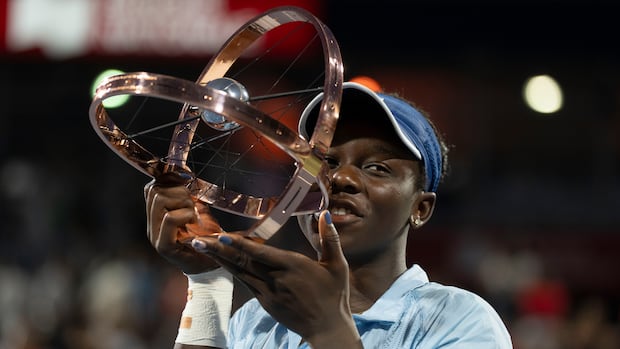This is an excerpt from The Buzzer, which is CBC Sports’ daily email newsletter. Stay up to speed on what’s happening in sports by subscribing here.
On Thursday night in Montreal, 18-year-old Victoria Mboko completed one of the most stunning runs in Canadian tennis history, defeating four-time Grand Slam champion and former world No. 1 Naomi Osaka to win the National Bank Open for her first WTA Tour title.
Playing through a wrist injury suffered during her semifinal win over ninth-seeded Elena Rybakina, the precocious Canadian teen rallied from another rough opening set for a 2-6, 6-4, 6-1 victory over an increasingly sullen Osaka, who hasn’t won a tournament since the 2021 Australian Open. Against Rybakina the previous night, Mboko dropped the first set 6-1 before roaring back to take the next two 7-5, 7-6 (4) against the 2022 Wimbledon champion.
Before that, Mboko upset top-seeded Coco Gauff (the 2025 French Open and 2023 U.S. Open champion) and No. 23 Sofia Kenin (the 2020 Australian Open champ) — both in straight sets. She’s the youngest woman to knock off four Grand Slam winners in the same tournament since a 17-year-old Serena Williams did it at the 1999 U.S. Open to capture the first of her Open-era record 23 major titles.
The National Bank Open (known as the Canadian Open before various sponsor-related re-brandings) is obviously not as prestigious as the U.S. Open. But it is classified as a WTA 1000 event — the highest tier in terms of prize money and rankings points offered on the women’s tour apart from the four Slams. Mboko took home $752,275 US for her victory — dwarfing her previous career earnings of $458,001 — along with 1,000 points.
With that boost, Mboko continued her meteoric rise up the world rankings. She began the year at No. 333 before winning five titles in six starts on the lower-level ITF Tour. After reaching the final of the clay-court Parma Ladies Open (a WTA 125 event) in May, Mboko had an impressive Grand Slam debut, making the third round of the French Open as a qualifier. That moved her into the top 100 for the first time, and a second-round showing at Wimbledon bumped her up to No. 85 entering the National Bank Open. Last night’s victory pushed her all the way to No. 24 — one spot ahead of Osaka and higher than any other Canadian singles player.
Victoria Mboko capped an unreal run in Montreal to capture the National Bank Open title.
Next stop: the U.S. Open
Mboko announced today that she’s skipping the Cincinnati Open, another WTA 1000 event, due to her sore wrist. She’d been slated to face No. 14 Diana Shnaider of Russia in the round of 64 on Saturday.
Assuming she’s healthy, Mboko will return for the U.S. Open, beginning Aug. 24. She’ll be among the 32 seeded players in the women’s draw in New York, giving her (at least on paper) a more favourable path at the final Grand Slam of the year.
If you’re experiencing deja vu right now, you’re not alone. In 2019, an unseeded teenager named Bianca Andreescu became the first Canadian woman in 50 years to win the Canadian Open (then called the Rogers Cup) when Serena Williams quit their final in Toronto due to back spasms with Andreescu leading 3-1 in the first set. A month later, the 19-year-old Andreescu shocked Williams in straight sets in the U.S. Open final to become Canada’s first (and still only) Grand Slam singles champion.
The Canadian tennis star in the making reflected on her unlikely NBO tournament run in Montreal.
Beyond their age in their breakthrough season (Mboko turns 19 later this month), the two players share some other biographical similarities. Both are the children of immigrants (Andreescu’s are from Romania, while Mboko’s came from Congo with a stop in North Carolina, where she was born) who settled in the Toronto area (Mboko grew up in Burlington, Ont., Andreescu in Mississauga). And both had their family dog in the stands, with the Mbokos’ Ivy following in the pawprints of the Andreescus’ Coco.
Having said all that, it of course would not be fair to expect Mboko to duplicate Andreescu’s monumental victory at the U.S. Open. But if she proved anything this week in Montreal, it’s that no one knows where the ceiling is right now for Canada’s newest tennis sensation.







